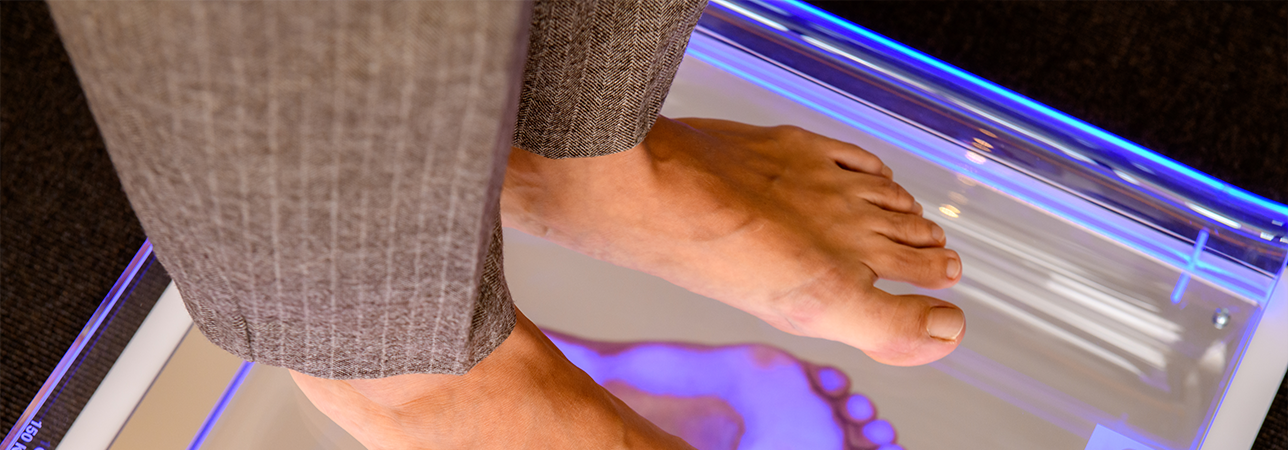
Morton’s neuroma
Morton’s neuroma is very painful condition in which excess pressure is applied to the nerves under the metatatarsal bone.
Symptoms
Those affected often report a burning pain under the third and fourth toes. They may also experience numbness in their toes, shooting pains, or a painful clicking when walking.
Causes
The pain associated with Morton’s neuroma occurs because the nerves are not working properly. The malfunction arises as a result of excessive strain on the sensitive nerves. To counteract this strain, the connective tissue changes, new blood vessels form and protein begins to accumulate around the affected nerve. It is this process that causes the pain that is typical of the condition.
The most common trigger of Morton’s neuroma is splayfoot. However, it can also be aggravated by wearing shoes that are too tight.
Diagnosis
As there is a large number of other conditions that have similar symptoms, it is important to consult a specialist. They will use special examination methods to detect whether it is in fact Morton’s neuroma.
Mulder sign (Mulder’s click)
During the examination, the metatarsal heads are compressed. In this examination, targeted pressure is applied to trigger the described pain.
Ultrasound examination
An ultrasound examination can detect inflammation and diagnose Morton’s neuroma.
MRI scan
This examination is the standard diagnostic method for detecting Morton’s neuroma. An added benefit of MRI is that it can easily identify conditions that have similar symptoms.
Treatments
Conservative therapies
If splayfoot is identified at the point of diagnosis, it is possible to treat Morton’s neuroma without surgery.
The treatment focuses on stabilising and relieving pressure on the arch of the foot. Splayfoot tape or customised insoles are used to reduce pressure on the Morton’s neuroma. In the next stage of treatment, physiotherapy is used to strengthen the foot muscles, and the pressure on the foot and nerves are permanently reduced with the aid of special insoles.
In the case of advanced Morton’s neuroma, injections of cortisone and painkillers can provide considerable pain relief.
Surgical treatment
The further the condition has progressed and the larger the Morton’s neuroma has grown, the greater the need for surgical intervention. If the Morton’s neuroma has a diameter of more than 6 mm, an operation is necessary because conservative therapy can no longer stop further progression.
Surgery without removing the nerve
The aim of this operation is to relieve the pressure on the nerves by changing the load distribution of the bones in the foot. Any malpositioned foot bones are rectified and, if necessary, corrections are made to the intermetatarsal ligament between the affected toes.
Surgery with removal of the nerve
If a very large Morton’s neuroma has been diagnosed, the affected section of the nerve is removed. This is a minimally invasive procedure that can be performed on an outpatient basis.
Aftercare
Treatment without removing the nerve
The patient will stay in hospital for two to three days, after which recovery takes up to six weeks. During this time, the patient will use a ‘short walker’ or crutches to relieve pressure from the area affected by the surgery.
Removal of the affected nerve
The foot can bear weight immediately and the patient only has to use crutches for a few days. The treatment is completed after the wound has healed, which takes around two weeks.
FAQs
Can I do sports again after ankle surgery?
If the diseased nerve has been removed, in very rare cases, a similar clinical picture can occur.
How do I prevent ankle osteoarthritis?
A short walker is an orthotic boot that effectively immobilises the foot and lower leg. It immobilises and relieves pressure from the affected areas when walking. Short walkers are often used as a substitute for plaster casts.




